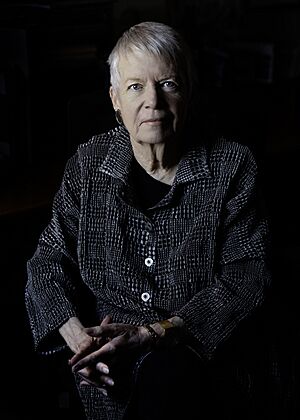Jill Tarter facts for kids
Quick facts for kids
Jill Tarter
|
|
|---|---|

Tarter at her home in 2025
|
|
| Born |
Jill Cornell
January 16, 1944 |
| Education | Cornell University (BS) University of California, Berkeley (MS, PhD) |
| Known for | SETI research |
| Spouse(s) | C. Bruce Tarter Jack Welch |
| Children | 1 daughter |
| Scientific career | |
| Fields | Radio astronomy |
| Thesis | The Interaction of Gas and Galaxies within Galaxy Clusters (1975) |
| Doctoral advisor | Joseph Silk |
Jill Tarter is an American astronomer born on January 16, 1944. She is famous for her work in the search for extraterrestrial intelligence, often called SETI. Tarter used to be the director of the Center for SETI Research. She also held a special position called the Bernard M. Oliver Chair for SETI at the SETI Institute. In 2002, Discover magazine named her one of the 50 most important women in science.
Early Life and Education
Jill Tarter grew up in New York State. She finished high school in 1961. Her father was a big inspiration for her. He encouraged her to be curious, even when others thought she should choose different paths. Jill decided she wanted to be an engineer from a young age. On family trips, she would look at the night sky and wonder if anyone else was out there.
Tarter went to Cornell University and earned a degree in Engineering Physics in 1965. She was the only woman in her engineering class of 300 students. Her interest in astronomy grew while she studied for her master's degree (1971) and PhD (1975) at the University of California at Berkeley. For her PhD, she studied small, dim objects in space. She even created the term "brown dwarf" to describe them. These objects are too small to create energy like stars do.
Astronomy Career and SETI Research
Jill Tarter has worked on many big science projects. Most of her work has been about finding extraterrestrial life. When she was a student, she was inspired by a report called the "Cyclops Report." This report talked about how to search for signals from space. She started working on a project called SERENDIP. This project used radio telescopes to listen for messages from intelligent life. The name SERENDIP is a fun backronym for "Search for Extraterrestrial Radio Emissions from Nearby Developed Intelligent Populations."
From 1992 to 1993, she was a project scientist for NASA's High Resolution Microwave Survey. Later, she became the director of Project Phoenix. This project continued the search for signals from space. In 2002, she helped create the HabCat catalog with Margaret Turnbull. This catalog lists stars that might have planets where life could exist.
Jill Tarter has written many scientific papers. She also gives many talks about the search for alien life. She also speaks about how important good science education is. After 35 years of searching for life beyond Earth, she retired in 2012.
In 2006, Tarter talked on a podcast called "Point of Inquiry." She discussed the question, "Are we alone?" She said that if we find out we are not alone, it would change how humans see themselves.
In 2011, Tarter gave a speech at the first Starmus Festival. This festival combines astronomy, science, music, and art. Her talk was called "Intelligent Life in the Universe: Is Anybody Out There?" She later joined the festival's board of directors. Other famous people like Stephen Hawking and Brian May are also on the board. Her 2011 talk was later published in a book. Jill Tarter is also on the advisory boards for CuriosityStream and Space for Humanity.
In 2017, a book about Jill Tarter and the history of SETI was published. It is called Making Contact: Jill Tarter and the Search for Extraterrestrial Intelligence.
Awards and Honors
Jill Tarter's work in astrobiology and her success as a woman in science have earned her many awards.
- In 1989, she received a Lifetime Achievement Award from Women in Aerospace.
- She was chosen as a Fellow of the Committee for Skeptical Inquiry in 1994.
- The Chabot Observatory named her their person of the year in 1997.
- In 2001, she received the Telluride Tech Festival Award of Technology.
- She was elected a Fellow of the American Association for the Advancement of Science in 2002.
- In 2003, she became a Fellow of the California Academy of Sciences.
- She also received the Adler Planetarium Women in Space Science Award in 2003.
- Time Magazine named her one of the 100 most influential people in the world in 2004.
- NASA gave her two public service medals.
- In 2005, an asteroid was named after her: Asteroid 74824 Tarter.
- She received Wonderfest's Carl Sagan Prize for Science Popularization in 2005.
- In 2009, she was given a TED Prize.
- She was elected a Legacy Fellow of the American Astronomical Society in 2020.
- In 2021, she became a member of the American Academy of Arts and Sciences.
See also
 In Spanish: Jill Tarter para niños
In Spanish: Jill Tarter para niños

